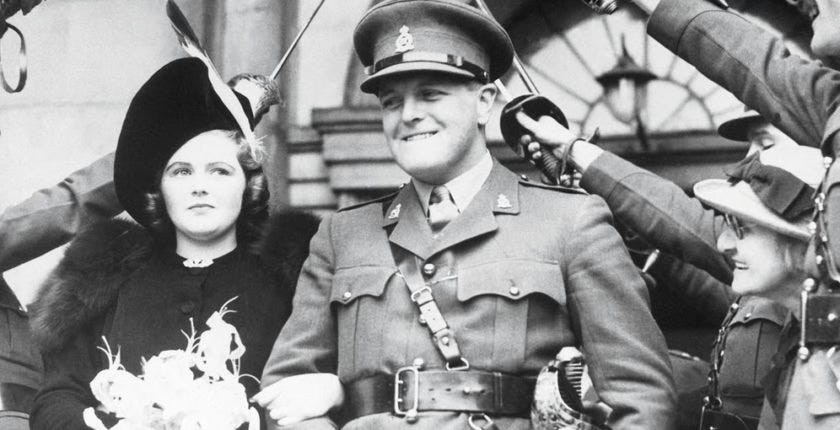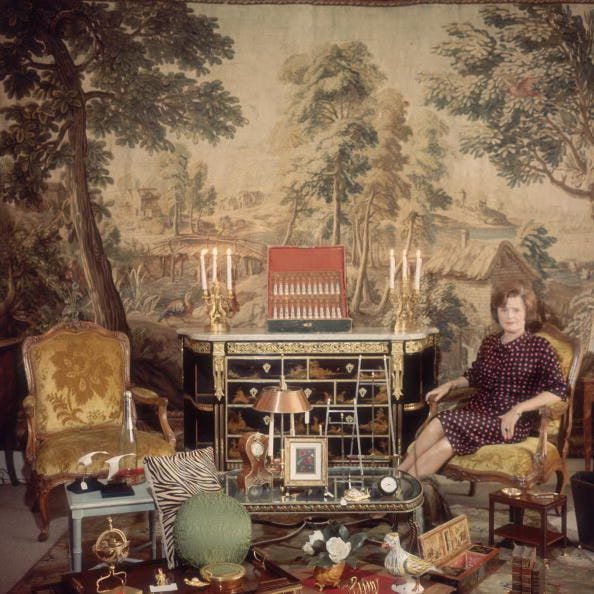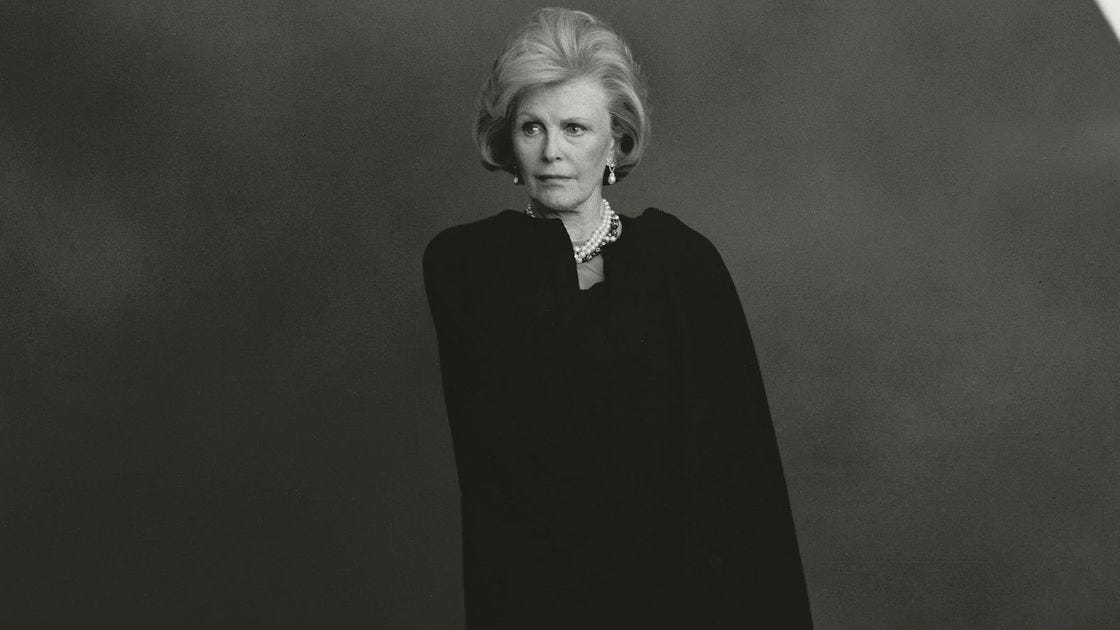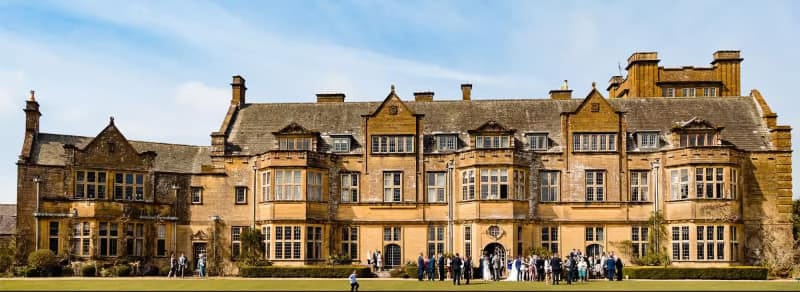“Living in the past is a dull and lonely business; looking back strains the neck muscles, causing you to bump into people not going your way.”
— Pamela Churchill Harriman
Pamela Churchill Harriman led an extraordinary life that spanned continents, marriages to powerful men, and a prominent career in American politics.
Table of Contents: Early Life and Background / Education / Randolph Churchill / Leland Hayward / Averell Harriman / Political Career & Fundraiser / Ambassadorship to France / Legal Troubles
If you aren’t subscribed yet, hit the subscribe button below to receive the Adorable Stories every weekend, directly in your inbox:
Early Life and Background
Pamela Beryl Digby was born on March 20th, 1920, at Farnborough, Hampshire, England.
She came from an aristocratic background: her father, Edward Digby, was the 11th Baron Digby, while her mother, the Honorable Constance Pamela Alice, was the daughter of Henry Campbell Bruce, 2nd Baron Aberdare.
The Digby family had a long history in British society, with ties to land ownership and political influence.
Her great-great aunt was the nineteenth-century adventurer and courtesan Jane Digby (1807–1881), notorious for her exotic travels and scandalous personal life.
Pamela was to follow in her relative’s footsteps, and has been called “the 20th-century’s most influential courtesan.”
Pamela spent part of her childhood in Australia, where her father had been dispatched as military secretary to the governor-general.
After returning back to England, Pamela’s childhood was spent largely at Minterne Magna, the family’s ancestral home in Dorset (photo below).
She had a younger sister, Leonora, and two younger brothers.
Education
Pamela was initially educated by a governess at Minterne Magna and later attended Downham School, a private boarding school for girls near Hatfield Heath, Essex.
From an early age she was a very good horsewoman and competed at shows like the International Olympia, Royal Bath and West Show.
At seventeen, Pamela’s formal education included a semester in Munich, Germany, during 1937 (at the time, Munich was considered a more “disciplined” destination abroad for English students, compared to Paris).
While in Munich, her friend Unity Mitford introduced her to Adolf Hitler and they had a tea together. Her account of their meeting was that:
“he seemed made of tinfoil as later caricatures made out and he was sort of nervous.”
Later, Pamela attended the Sorbonne in Paris, where she furthered her studies in French language and literature.
Pamela did not enroll in any university.
Randolph Churchill
Pamela’s first marriage was to Randolph Churchill, the son of British Prime Minister Winston Churchill.
Randolph was a notorious “womaniser” desperate for a wife (he had reportedly already proposed to eight women in the space of the previous two weeks), and proposed to Pamela on the very evening they met.
Friends and family warned her that the mercurial Randolph was not a good long-term risk: Conservative Chief Whip David Margesson, “took me for a long walk in the country and tried to dissuade me.”
She replied: “If he is not killed and we do not get on together, I shall obtain a divorce.”
They wed on October 4th, 1939, when Pamela was just 19 years old (photo below).

The marriage came during the early days of World War II: one year later, the couple had one son, Winston Churchill Jr., born on October 10th, 1940, but their marriage quickly deteriorated due to Randolph’s heavy gambling habits and alcohol addiction.
On February 1941, Randolph was sent to Cairo with the British Commandos, and managed to acquire new and substantial gambling debts during the initial boat journey from England to Egypt.
Pamela was left in London to cope alone with the young baby Winston and Randolph’s creditors: once he arrived in Cairo, her husband promptly sent her a letter asking her to make good on his new gambling debt amounting to GBP 12,000 (equivalent to over GBR 200,000 in 2025) and Pamela was forced to take a GBP 12-a-week job at the Ministry of Supply and sell most of her wedding presents and much of her jewellery to repay her husband’s debts (while managing to keep it a secret from her in-laws).
Pamela and Randolph separated in 1945 (when she started an affair with American envoy Averell Harriman, a married man 30 years her senior), and the two officially divorced in December 1946 on the grounds that Randolph had deserted her for three years.
Pamela would later convert to Catholicism and had her marriage with Randolph officially annulled by the Catholic Church in Rome.
After her separation from Randolph Churchill, Pamela moved to Paris with very little money in her pocket and started a five years affair with Gianni Agnelli, the dashing Italian heir to the FIAT empire.
Their romance flourished in the glamorous post-war European society, but it ultimately ended when Agnelli returned to Italy to marry Marella Caracciolo in 1953.
They mutually agreed to end their affair when he decided to marry Marella and, despite their breakup, their relationship remained one of the most talked-about love affairs of the 1950s and, decades later, Pamela would recall those five years as the happiest of her life.
Pamela’s next notable relationship was with Baron Elie de Rothschild (who was married at the time), a partner in the family bank, Rothschild Frères, who also ran the renown Château Lafite-Rothschild premier cru claret vineyard in Bordeaux: the Baron schooled her in art history and wine-making during this clandestine and short-lived relationship.
Leland Hayward
Pamela’s relationship with Leland Hayward, the celebrated Broadway and Hollywood producer, began in the 1950s while Hayward was still married to his second wife, Slim Keith.
After meeting Pamela, Leland Hayward decided to divorce from his wife.
On May 4th, 1960, Pamela and Hayward married, marking the beginning of a new chapter in her life amidst the glitz and glamour of the American cultural elite.

Hayward, was known as the producer of iconic works such as South Pacific and The Sound of Music, and introduced Pamela to the world of theater and Hollywood, where she quickly became a fixture in high society.
Unfortunately, Hayward’s health began to decline just a few years later, and he died from a heart attack on March 18th, 1971.
Averell Harriman
The day after Hayward’s funeral, Pamela arranged to resume her acquaintance with her former lover, the American diplomat Averell Harriman (a former Ambassador to the Soviet Union and Great Britain), then 79 years old and recently widowed.
They were married on September 27th, 1971.
Despite a 30-year age difference, their marriage was a dynamic union, with Harriman providing Pamela with a platform to enter the world of American politics at the highest level. Together, they became key figures in the Democratic Party, with Pamela using her charm and social connections to host influential fundraisers and political salons.
Their marriage lasted until Harriman’s death on July 26th, 1986, after which Pamela continued the political work they had begun together.
Political Career & Fundraiser
“In war you can only be killed once, but in politics, many times.”
— Winston Churchill
After becoming an American citizen in 1971, Pamela Harriman transitioned from her role as a socialite to a highly influential figure within the Democratic Party.
Following the death of her third husband, Averell Harriman, in 1986, she used her wealth, connections, and social skills to become a formidable political fundraiser.
Pamela became known for hosting lavish political salons at her Georgetown home, where she united prominent politicians, business leaders, and donors to raise funds for the Democratic Party.
She played a critical role in revitalizing the party during the 1980s and 1990s, helping to bankroll key campaigns, including Bill Clinton’s successful 1992 presidential bid.
Her efforts earned her the nickname “the ultimate political hostess.”
Ambassadorship to France
In recognition of her contributions, President Bill Clinton appointed her as the U.S. Ambassador to France in 1993. As ambassador, Pamela was praised for her diplomatic skills and for strengthening Franco-American relations.
The Dayton Agreement (to bring peace to Bosnia and Herzegovina after the three-and-a-half years of Bosnian war) was formally signed in Paris in 1995 while she served as ambassador.
Legal Troubles
In 1994, after the death of her third husband Averell Harriman, Pamela faced significant legal issues with his children from his previous marriages, particularly with his daughter, Kathleen Harriman Mortimer.
Harriman’s children accused Pamela of manipulating their elderly father into changing his will and leaving the bulk of his vast fortune — estimated at approximately USD 100 million — to her and mismanaging the Trust incorporated in favour of the heirs.
These accusations were exacerbated by Pamela’s effective active role in managing the Harriman estate (especially in her husband’s final years) and her use of its resources to fund her political activities, including her prominent role in Democratic Party fundraising during the 1980s.
The legal battle was eventually settled out of court in 1995, with Pamela reportedly retaining the majority of Harriman’s estate, including substantial financial assets, art collections, and real estate holdings, but agreeing to certain (undisclosed) concessions in favour of his heirs.
Pamela’s extraordinary life came to an end on February 5th, 1997, when she suffered a fatal brain hemorrhage while swimming at the Ritz Hotel in Paris.
She was 76 years old.
Following her passing, President Bill Clinton appointed Felix Rohatyn (extensively featured in the Adorable Story #18), a prominent financier and former chairman of Lazard Frères, as the next U.S. Ambassador to France.
—Alberto @
Do you know anyone who would love to read this Adorable Story? Show your support by sharing Adorable Times’ Newsletter and earn rewards for your referrals.












